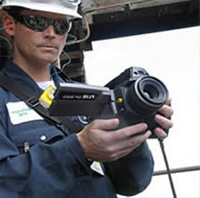Inspection Services
Electrical / Mechanical Thermal Imaging Inspections:
Thermal imaging is an effective and valuable diagnostic tool in a predictive maintenance program. With infrared thermography you can avoid costly failures in power generation, transmission and distribution systems as infrared cameras detect anomalies before trouble strikes and service is affected. PM programs that use thermal imaging limit downtime by preventing unplanned shutdowns and by streamlining repair and maintenance planning.
The resulting cost-saving and safety benefits from thermal imaging inspections include energy savings, protection of equipment and capital investments, reduced insurance premiums, faster diagnosis as well as establishing repair priorities based on severity.
Thermal imaging inspections are non-destructive and do not interrupt day-to-day operations. An IR camera can detect problems and areas of concern that cannot be detected with a visual inspection.
Circuit Breaker Testing:
Test results on circuit breakers by NETA (International Electrical Testing Association) show over a 15% failure rate. Defective circuit breakers, motor contactors and protective relays fail because they are mis-wired or broken. Trip linkages fail because of dust, hardened grease, corrosion and misalignment. The current-carrying parts and main contacts fail because they have been damaged by fault interruption or operating springs have fatigued so they no longer provide adequate opening and closing force.
In today’s economic environment, a combination of periodic testing to ascertain breaker condition including contact resistance, insulation resistance and / or hi-pot testing, operation and timing testing and visual inspections coupled with maintenance efforts which restores the breaker based on the results of the testing program.
Optical Gas Imaging Inspections
Oil/Natural Gas Applications:
Optical gas imaging is the safest, most efficient method for leak detection in the oil refinement process and a requirement of many Federal and State environmental agencies. The major natural gas products, methane and ethane, are easily detected by thermal imaging, and we provide leak detection services to all portions of the industry, from production and storage to transportation and distribution.
Benefits include:
- Prevent loss of product that could otherwise be sold to customers
- Prevent work delays or halts
- Bring LDAR plans into compliance with regulators
- Protect the environment
- Petrochemical Applications
A wide range of hydrocarbon and inorganic chemicals show good visibility with gas-detecting cameras, regardless of purity. In any given petrochemical facility, there are hundreds, or even thousands of potential leak sources. The use of traditional testing methods requires the inspector to manually test each site with a volatile organic compound meter, or “sniffer”. However, the use of IR imaging allows for testing of numerous sites in a faster time, thus making the process cheaper and more efficient. Leaks can be detected from many different sources in the petrochemical industry, but the most common leak paths occur from flanges, valve stems, machinery, passing valves, instrument connections, couplings, drain covers, holes, plugs and caps and pump seals.
SF6 Gas Detection:
Sulfur Hexafluoride (SF6) is a gas commonly used as an insulator in the electrical utilities industry, typically in high voltage switchgear and transformers. Although very useful, it is a highly potent greenhouse gas, being several thousand times worse than CO2 in terms of environmental impact. Leaks commonly occur at flanges, bushings, bursting discs, and valve stems. Due to its unique properties, there are few alternative substances. Consequently, the US government is increasing regulation of the gas through a combination of incentives and punishments. Reduction of SF6 emissions through leakage pays off. The long-wave FLIR cameras employed by our firm are highly sensitive to SF6, detectable to leaks as small as 0.25 kg/year.
CNA Insurance Saves Clients More Than $105m in Risks and Losses






